Florida Panther
 The Florida Panther is a 50-foot long installation that occupies the median on Monroe Street opposite the entrance to the Harborside Event Center. It is framed by opposing 8-foot square basins that feature gurgling white-water bubblers which send gentle ripples cascading through narrow chutes into lower rectangular receiving pools. An adult male panther prowls atop the northernmost basin; a female
The Florida Panther is a 50-foot long installation that occupies the median on Monroe Street opposite the entrance to the Harborside Event Center. It is framed by opposing 8-foot square basins that feature gurgling white-water bubblers which send gentle ripples cascading through narrow chutes into lower rectangular receiving pools. An adult male panther prowls atop the northernmost basin; a female  reclines in the corner of the southern basin, where she lazily keeps a watchful eye on a cub sitting on the ledge across from her. A large bullfrog squats near the cub, ready to dive into the safety of the water should the cub move a muscle in its direction.
reclines in the corner of the southern basin, where she lazily keeps a watchful eye on a cub sitting on the ledge across from her. A large bullfrog squats near the cub, ready to dive into the safety of the water should the cub move a muscle in its direction.
The panthers and the frog are made of cold cast bronze. The basins consist of poured concrete and cast stone.  The fountains are fed by a pool pump hidden beneath a plaster rock screened from all but the most discriminating view by palms and shrubbery.
The fountains are fed by a pool pump hidden beneath a plaster rock screened from all but the most discriminating view by palms and shrubbery.
The installation was dedicated October 22, 1988.
Why Florida Panthers?
 The panther is the Florida state animal. It was chosen for the honor in 1982 by a vote of students throughout the state. As the plaque mounted on the side of the northern tidal pool states, the Florida Panther is on a “countdown to extinction.”
The panther is the Florida state animal. It was chosen for the honor in 1982 by a vote of students throughout the state. As the plaque mounted on the side of the northern tidal pool states, the Florida Panther is on a “countdown to extinction.”
The Florida Panther has been on the federal endangered species list since 1967 and on the state’s endangered list since 1973.  But it has actually been illegal to hunt the big cats (which also go by the names of “catamounts” and “painters”) in Florida since 1958.
But it has actually been illegal to hunt the big cats (which also go by the names of “catamounts” and “painters”) in Florida since 1958.
At one time, these elusive large cats ranged as far west as Texas and Arkansas and as far north as Tennessee and South Carolina. Today, the panthers have lost roughly 95% of their historic habitat, and  their current range is squeezed into a handful of protected areas in Southwest Florida such as Big Cypress National Preserve, the Florida Panther National Wildlife Refuge, and some private lands. But even here, the vitality of their habitat is undermined loss of vegetation and prey resulting from drought, wildfires and salt water intrusion. [The latter is a
their current range is squeezed into a handful of protected areas in Southwest Florida such as Big Cypress National Preserve, the Florida Panther National Wildlife Refuge, and some private lands. But even here, the vitality of their habitat is undermined loss of vegetation and prey resulting from drought, wildfires and salt water intrusion. [The latter is a  complication connected to sea level rise and the interruption of the flow of water from Lake Okeechobee into the Everglades, a situation that is further exacerbated by the presence of Tamiami Trail. For more information on this problem, see Fast Facts #2 below.]
complication connected to sea level rise and the interruption of the flow of water from Lake Okeechobee into the Everglades, a situation that is further exacerbated by the presence of Tamiami Trail. For more information on this problem, see Fast Facts #2 below.]
It’s not just that  housing developments, commercial construction and roadbuilding continue to encroach upon the Panthers’ few remaining population areas. They cut them off from one another. As males and breeding pairs roam between these fragmented environments to hunt and mate, they risk being hit and killed by motorists. In 2016, the Florida Fish
housing developments, commercial construction and roadbuilding continue to encroach upon the Panthers’ few remaining population areas. They cut them off from one another. As males and breeding pairs roam between these fragmented environments to hunt and mate, they risk being hit and killed by motorists. In 2016, the Florida Fish  and Wildlife Conservation Commission listed 42 panther deaths, 34 as a result of motor vehicles, including 16 females (up from 30 vehicle-related panther deaths in 2015 and 24 in 2014).
and Wildlife Conservation Commission listed 42 panther deaths, 34 as a result of motor vehicles, including 16 females (up from 30 vehicle-related panther deaths in 2015 and 24 in 2014).
A number of other factors militate against the viability 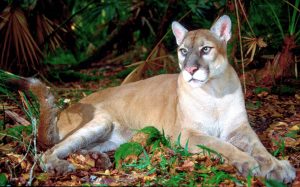 of the panther as a species. Their lifespan in the wild is only about 12 years, litters only range in size from one to four cubs, and breeding pairs require 200 square miles of habitat to roam and hunt.
of the panther as a species. Their lifespan in the wild is only about 12 years, litters only range in size from one to four cubs, and breeding pairs require 200 square miles of habitat to roam and hunt.
But the most significant challenge encountered by panthers today are the health problems emanating from inbreeding.  Findings of a population viability analysis in 1992 speculated that the Florida panther would become extinct in 24-63 years due to its small population size and associated inbreeding (Seal et. al. 1992). A plan for genetic restoration was prepared in 1994 to reduce the occurrence of inbreeding, restore genetic variability
Findings of a population viability analysis in 1992 speculated that the Florida panther would become extinct in 24-63 years due to its small population size and associated inbreeding (Seal et. al. 1992). A plan for genetic restoration was prepared in 1994 to reduce the occurrence of inbreeding, restore genetic variability  and vitality, and restore genetic diversity levels to that typical of other puma subspecies (U. S. Seal, 1994).
and vitality, and restore genetic diversity levels to that typical of other puma subspecies (U. S. Seal, 1994).
In 1995, 8 female pumas from Texas (Puma concolor stanleyana) were released throughout Florida panther range in South Florida to alleviate the genetic problems plaguing this isolated and inbred population.  Texas pumas were chosen because they are the closest living relative to the Florida Panther and one with which they historically interbred. Five of the eight Texas pumas produced offspring. Five died in the wild from various causes and the remaining three were removed to captivity during the 2002-2003 capture season after they contributed to Florida Panther genetic introgression
Texas pumas were chosen because they are the closest living relative to the Florida Panther and one with which they historically interbred. Five of the eight Texas pumas produced offspring. Five died in the wild from various causes and the remaining three were removed to captivity during the 2002-2003 capture season after they contributed to Florida Panther genetic introgression  efforts.
efforts.
The initiative did reestablish a healthy and diverse Florida panther gene pool and reduced the frequency of several of the inbreeding depression indicators such as atrial septal defects (holes in the heart), cryptorchidism (undescended testicles), kinked tails and cowlicks, with population estimates increasing from 30-80 to 80-100 adults. Because the Florida  panther population remains isolated it will likely become necessary to enrich the population, as before, by releasing females from other populations at some point in the future. Scientists are carefully monitoring the population to determine when this becomes necessary. However, the survival and recovery of the Florida panther is clearly dependent upon protection of the small, remaining population, its
panther population remains isolated it will likely become necessary to enrich the population, as before, by releasing females from other populations at some point in the future. Scientists are carefully monitoring the population to determine when this becomes necessary. However, the survival and recovery of the Florida panther is clearly dependent upon protection of the small, remaining population, its  habitats and prey resources.
habitats and prey resources.
However, the death-to-birth rate is not in the panthers’ favor. In 2016, for example, only 14 cubs were born in a total of six litters, producing a discouraging 42:14 death-to-birth ratio for that year.
FWC 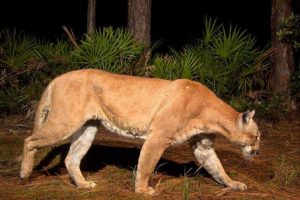 told Florida Weekly in January of 2017 that based on radio collars, hired trackers and other information, there remain as few as 100 and no more than 180 Florida Panthers in the wild. See Williams, Roger, “Panthers continue to lose in fight against traffic,” Florida Weekly (Vol. X, No. 41, Jan. 18-24, 2017.)
told Florida Weekly in January of 2017 that based on radio collars, hired trackers and other information, there remain as few as 100 and no more than 180 Florida Panthers in the wild. See Williams, Roger, “Panthers continue to lose in fight against traffic,” Florida Weekly (Vol. X, No. 41, Jan. 18-24, 2017.)
The Florida 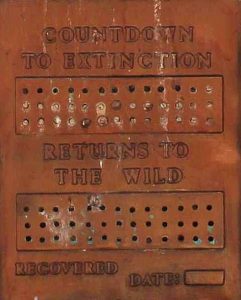 Fish and Wildlife Conservation Commission is responsible for management and preservation of this endangered State Animal. The future of this large animal depends entirely on the management decisions that FWC makes today and in the future on its behalf.
Fish and Wildlife Conservation Commission is responsible for management and preservation of this endangered State Animal. The future of this large animal depends entirely on the management decisions that FWC makes today and in the future on its behalf.
Both the City of Fort Myers and the sculptor hope that The Florida Panther helps draw attention to the plight of this “highly-endangered species.
A word about D.J. Wilkins
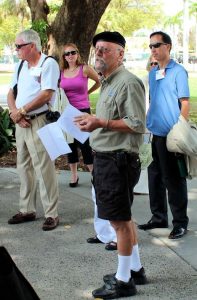 The Florida Panther is the creation of local artist D.J. Wilkins, who also engineered, wired, piped and constructed the basins where the Florida Panther roams. Proclaimed the “Sculptor of Fort Myers” by former mayor Art Hammel and the City Council that served during his administration, Wilkins is responsible for 23 of the public sculptures in the city of Fort Myers, including Uncommon Friends and The Great Turtle Chase at the Edwards Drive entrance into Centennial Park, Clayton (also in Centennial Park), The Harborside Collection (seven works including Chief Billy Bowlegs, Thomas Edison, Tootie McGregor Terry, James D. Newton and Connie Mack), several works for the Edison Ford Estates Collection (including a bust of Henry Ford and heroic size sculptures of Thomas Edison,
The Florida Panther is the creation of local artist D.J. Wilkins, who also engineered, wired, piped and constructed the basins where the Florida Panther roams. Proclaimed the “Sculptor of Fort Myers” by former mayor Art Hammel and the City Council that served during his administration, Wilkins is responsible for 23 of the public sculptures in the city of Fort Myers, including Uncommon Friends and The Great Turtle Chase at the Edwards Drive entrance into Centennial Park, Clayton (also in Centennial Park), The Harborside Collection (seven works including Chief Billy Bowlegs, Thomas Edison, Tootie McGregor Terry, James D. Newton and Connie Mack), several works for the Edison Ford Estates Collection (including a bust of Henry Ford and heroic size sculptures of Thomas Edison, 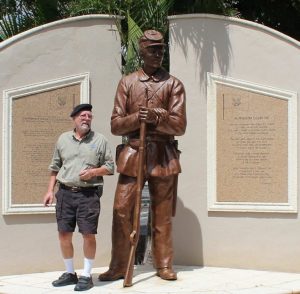 Mina Edison and Henry Ford), statues of Thomas Edison for the Lee and Collier campuses of Edison State College, and the Wes Nott statue on the Lee Memorial Hospital campus on Cleveland Avenue South.
Mina Edison and Henry Ford), statues of Thomas Edison for the Lee and Collier campuses of Edison State College, and the Wes Nott statue on the Lee Memorial Hospital campus on Cleveland Avenue South.
Wilkins also played an instrumental role in restoring three of Southwest Florida’s public sculptures, The Spirit of Fort Myers at the entrance to Edison Park, the Tootie McGregor Fountain in front of the Edison Restaurant at the Fort Myers Country Club and the Iwo Jima Memorial in Eco Park on Veteran’s Parkway in Cape Coral.
Location and Measurements.
 The installation is located at in the median at 1375 Monroe Street, Fort Myers, FL 33901.
The installation is located at in the median at 1375 Monroe Street, Fort Myers, FL 33901.- Its coordinates are 26d 38′ 39.3966″ N longitude and 81d 52′ 20.5716″ W latitude.
- The lower basins are 15 inches tall, 76 inches long and 64 inches wide. The top ledge is 8 inches wide.
- The upper basins stand 33 inches tall and are 8 feet square. The top ledge is 16 inches wide so that the pool itself is
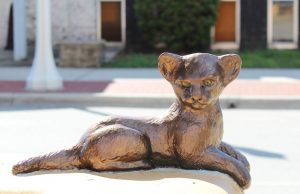 64 inches square.
64 inches square. - The male panther is 60 inches nose to tip of the tale; 24 inches high at the haunch;and 17 inches wide nose to paw.
- The female is46 inches long, 20 inches tall and 33 inches across at the tale.
- The cub is 20 inches long, 10 inches tall at the ear and 7 inches wide. The cub’s head has a split in the bronze which is several inches long.
Fast Facts About the Sculptor.
 D.J. Wilkins worked in heating, ventilation and air conditioning when he first arrived here in 1975 from Breckinridge, Kentucky, where he was teaching students skills like welding as part of a stint in the Job Corps.
D.J. Wilkins worked in heating, ventilation and air conditioning when he first arrived here in 1975 from Breckinridge, Kentucky, where he was teaching students skills like welding as part of a stint in the Job Corps.- He credits his mother with his choice of Fort Myers. “’Fort Myers is the prettiest place I’d ever seen,’ she told me once,” DJ recalls.
- The seeds of his sculpting career were planted after he “escaped here” when a “hippie friend” on Fort Myers Beach showed him art he’d created out of cypress wood. They rode in a 1960 GMC pickup truck to a Naples art gallery where Wilkins saw sculptures that inspired him.
Fast Facts About Sea Level Rise and Salt Water Intrusion in the Everglades
 The more freshwater there is in the Everglades, the less saltwater can intrude into the habitat.
The more freshwater there is in the Everglades, the less saltwater can intrude into the habitat.- Today, two manmade structures interfere with the flow of freshwater into and through the Everglades.
- The first is the Herbert Hoover Dike, which surrounds Lake Okeechobee. Prior to construction of the dike in the
 1930s, water would flow south from the lake into the Everglades, particularly during rainy season. Now, when water levels in Lake Okeechobee rise about 14 feet, the Army Corps of Engineers release the excess west into the Caloosahatchee River and east into
1930s, water would flow south from the lake into the Everglades, particularly during rainy season. Now, when water levels in Lake Okeechobee rise about 14 feet, the Army Corps of Engineers release the excess west into the Caloosahatchee River and east into 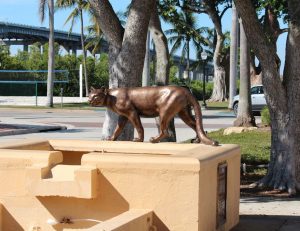 the St. Lucie.
the St. Lucie. - Tamiami Trial also acts as a dam of sorts, further preventing the flow of water from north to south.
- The Comprehensive Everglades Restoration Program was created by the U.S. Congress in 2000 to restore water flow. But sea level rise was not taken into account when the program was developed. As a result, resource managers only release freshwater into the Everglades during rainy season (June to November). But saltwater intrusion occurs most during dry season, particularly March through May.
- According to scientists in Florida International University’s Southeast Environmental Research Center and FIU’s Sea Level Solutions Center, sea levels rose 2.2 centimeters annually from 2011 to 2015.
- In 2012, sea levels rose 10 centimeters in the dry season months of December to May and have not subsided.
- Many factors contributed to the drastic increase in 2012, including melting ice sheets, a strong La Niña season in 2011, and slow ocean currents that allowed sea water to pile up along coastlines.
- Parts of the coastal Everglades that were once flooded by sea water about 70 percent of the time are now covered by sea water 90 percent of the time.
- The coastal Everglades is a delicate ecosystem that depends on the right balance of fresh water and salt water to stay healthy. Nestled in between marine and land environments, it is vulnerable to sea level rise because of its low ground level, loss of peat soil, tides and flooding, and excess marine nutrients.
- “We need to fight water with water,” said Rene Price, chair of FIU’s Department of Earth and Environment and co-author of the study. “To combat sea level rise in the Everglades, we recommend additional fresh water be delivered throughout the year, not just in the wet season.”
- Source: Gonzalez, Evelyn S., “Everglades needs more fresh water to fight salt water intrusion,” Phys.Org (2-6-2018).














 Tom Hall is both an amateur artist and aspiring novelist who writes art quest thrillers. He is in the final stages of completing his debut novel titled "Art Detective," a story that fictionalizes the discovery of the fabled billion-dollar Impressionist collection of Parisian art dealer Josse Bernheim-Jeune, thought by many to have perished during World War II when the collection's hiding place, Castle de Rastignac in southern France, was destroyed by the Wehrmacht in reprisal for attacks made by members of the Resistance operating in the area. A former tax attorney, Tom holds a bachelor's degree as well as both a juris doctorate and masters of laws in taxation from the University of Florida. Tom lives in Estero, Florida with his fiancee, Connie, and their four cats.
Tom Hall is both an amateur artist and aspiring novelist who writes art quest thrillers. He is in the final stages of completing his debut novel titled "Art Detective," a story that fictionalizes the discovery of the fabled billion-dollar Impressionist collection of Parisian art dealer Josse Bernheim-Jeune, thought by many to have perished during World War II when the collection's hiding place, Castle de Rastignac in southern France, was destroyed by the Wehrmacht in reprisal for attacks made by members of the Resistance operating in the area. A former tax attorney, Tom holds a bachelor's degree as well as both a juris doctorate and masters of laws in taxation from the University of Florida. Tom lives in Estero, Florida with his fiancee, Connie, and their four cats.